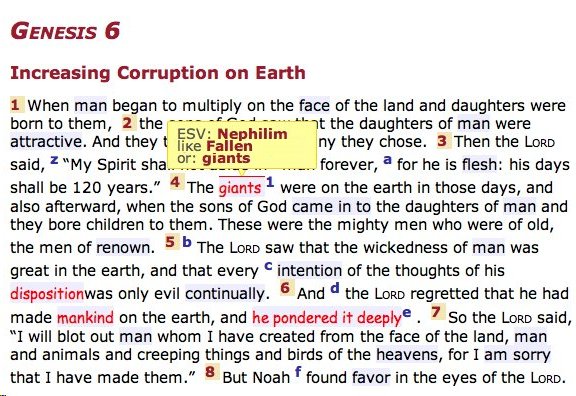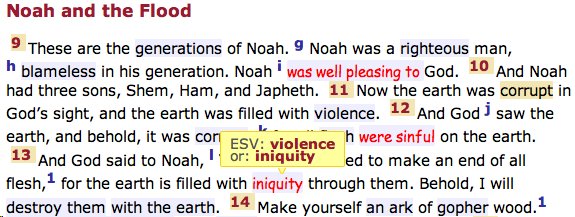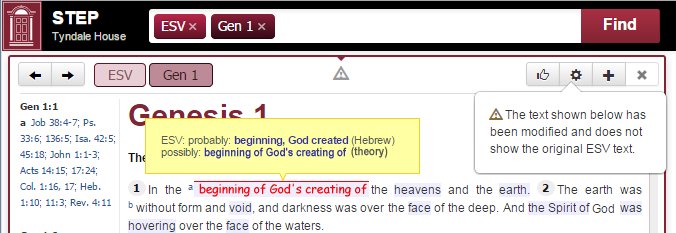STEPBible - Scripture Tools for Every Person - from Tyndale House, Cambridge
__
Manuscripts and Meanings
Feature not available yet. In active development. Contact us to help.
All bible translations represent decisions about what the original text was (based on manuscripts) and what the original text was intended to convey in the original culture (the meaning). A multitude of translations in modern languages confronts a bible student with numerous alternatives. These have been compiled in English using the ESV as a base text. This:
- Highlights words and phrases where there are viable alternate translations
- Allows the reader to choose an alternative to be displayed.
To use Manuscripts and Meanings:
- Choose Manuscripts and Meanings from the Display menu on the STEP toolbar.
- Clicking on a highlight text segment to display the alternatives.
- Click the alternative meaning that you wish to see displayed in your personal version.
- The personal alternatives will display in their own color.
The Manuscripts and Meanings displayed are the results of a long arduous scholarly process. They are important for knowing how the Bible could possibly be translated differently.
Different meanings are due to different translation styles or the ambiguity of the original word. They are marked as follows (more details here):
- Or: - an alternate possible meaning of the original language; e.g. "expanse" Or: "dome"
- Lit.: - a more literal translation of the original language; e.g. "expanse" Lit: "beaten surface"
- Means: - a more idiomatic translation of the original language; e.g. "expanse" Means: "vastness"
- KJV: - traditional translation in 17th C English, e.g. "expanse" KJV: "firmament"
- Like: - puns or phonetic ambiguity, e.g. "Adam" Sounds like: "man".
Different manuscripts give evidence about the original Hebrew and Greek text. Scholars have studied these for hundreds of years and there is broad consensus about the conclusions. The specific conclusions by the committees set up by the United Bible Society (UBS) are marked as:
- Probable: - The version which probably represents the oldest Hebrew text, according to the UBS Hebrew OT committee convened and recorded by D. Barthélemy.
- Possible: - A version which the committee deemed possible but less likely to be original.
OT Manuscript differences have support from various sources (more details here):
- Hebrew - (i.e. Masoretic) This is always the reading of the Leningrad codex that examplifies other manuscripts. When other Hebrew sources are noted elsewhere, this is labelled as "most Hebrew".
- some Hebrew - old Hebrew manuscripts that differ from the Leningrad codex, including:
- Qumran - Hebrew texts placed in caves in the Judean desert, about 200-0 BC
- Geniza - Hebrew texts stored in a Cairo Synagogue about 900-1100 CE
- Samaritan - a separate tradition of the Pentateuch preserved by Samaritans
- Aramaic - (i.e. Targums) Translations of Hebrew manuscripts from about 0-600 CE
- Syriac - (a.k.a. Peshitta) Translations of Hebrew manuscripts from about 200 BC - 200 CE
- Greek - (i.e. Old Greek & Septuagint) Translation of Hebrew manuscripts about 200-100 BC
- Latin - (i.e. Vulgate & Old Latin) Translations of Hebrew manuscripts from 0-400 CE
- Scribes - Notes by scribes from margins of Hebrew manuscripts or ancient tradtions (i.e. Qere & Tiqqune & Itture etc; more details here)
- theory - a reasonable conjecture which does not yet have any manuscript support
If any manuscript in a group (eg 'Greek') gives support to an alternate reading, this is noted, though individual manuscripts are not named. This means that sometimes the same group may support more than one reading because manuscripts in the same group may differ. When manuscripts support the Hebrew of the Leningrad Masoretic text, this is not normally noted, because at least some manuscripts in all language groups support the standard text in almost every case.
All variants in Barthélemy's UBS survey are included in the Hebrew text, and a subset of these are included in the ESV Manuscripts and Meanings. This committee considered all the possibilities which make a difference to the translation of the text.
NT Manuscript differences come from thousands of surviving Greek manuscripts in various forms and ancient translations as follows (more details here):
- p1, p2 etc. - Papyri (i.e. written on papyrus). 85 of which originate before 500 AD
- 01, 02 etc. - Uncials (i.e. written all upper case, on parchment). 74 originate before 500 AD
- 1, 2 etc. - Minuscule (i.e. written mostly in lower case). None originate before 500 AD
- L1, L2 etc. - Lectionaries (i.e. daily readings). 2 originate before 500 AD
- Q1, Q2 etc - Quotations mainly from church Fathers. 215 sources originate before 500 AD
- Lt - (i.e. Old Latin). Translations of Greek manuscripts. 15 originate before 500 AD
- Vg - (i.e. Jerome's Vulgate). Translation from Greek by Jerome about 400 AD
- Cp - (i.e. Coptic). Translation into a popular language of Egypt in 3rd or 4th century
- Sy - (i.e. Peshitta). Translation into Syriac in the 4th century
- Ar - (i.e. Armenian). Translation in the 5th century based on Syriac manuscripts
- Gg - (i.e. Georgian). Translation in the 5th century probably based on Armenian.
They are also marked according to the conclusions in two types of modern editions:
- Maj - (i.e. Majority Text). An edition based on Byzantine manuscripts from 6th to 15th century
- UBS - (i.e. UBS 3/4/5 & NA 27/28 Text). Editions based primarily on the earliest manuscripts.
All variants in the apparatus of UBS 3rd to 5th editions are included. This apparatus aims to list all variants which make a difference to the translation of the text. All witnesses originating before 500 AD are listed when they lend clear support to one variant over another.
Progress:
OT: 1st pass is finished and is now being second-edited.
NT: 1st pass is finishing
Personnel:
Project Director: David Instone-Brewer
Annotations Editor (i.e. primary author): Galen Goldsmith
Technical contributors: Charles L. Echols, Phil Church, Clayton Bartholomew
Second-Editors: Anna Smirnova, Lawrence Miles, Emma Hill, Coby Ingram , Dale Brueggemann
Example:
Gen.11.31: ... his son Abram's wife, and they went forth together from Ur
The user will see a popup when they hover over the text, saying
| Alternative manuscript evidence |
|---|
ESV: and they went forth together {supported by Hebrew manuscripts} Prob: he took them out {supported by Samaritan, Greek, Syriac & Latin manuscripts} |
The various elements of this popup provide more information on hover or click:
Prob: The probable older version, as determined by Barthélemy's UBS committee. Rated: Likely.
he took them out: Based on Hebrew emendation ויוציא אתם instead of יֵּצְאוּ אִתָּם
Hebrew: All Hebrew manuscripts including the Leningrad Codex have this text.
some Hebrew: Hebrew manuscripts that do not include Leningrad Codex have this text.
most Hebrew: Hebrew manuscripts including Leningrad Codex have this text.
Samaritan: Supported by the text of one or more Samaritan Pentateuch manuscripts
Greek: Supported by translation in one or more Old Greek / Septuagint manuscripts
Syriac: Supported by translation in one or more Old Syriac / Peshitta manuscripts
Latin: Supported by translation in one or more Old Latin / Vulgate manuscripts
If this alternative existed at Qumran then the "Prob:" line would include:
Qumran: Supported by the text of one or more of the Judean / Dead Sea Scrolls
Occasionally an emmendation with no manuscript support is marked as:
Theoretical: A suggestion that currently has no support from any manuscripts
www.STEPBible.org is created and supported by Bible scholars at Tyndale House, Cambridge
with a great deal of help from volunteers and partnering by many organisations.


